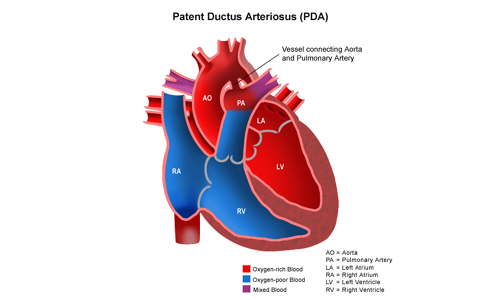Difference between PFO and PDA
PDA (patent ductus arteriosis) is a naturally occurring opening between the pulmonary artery and the aorta of the heart. It functions as a shunt by transmitting blood across the two vessels in a neonate and closes after birth. PFO (patent foramen ovale) is a birth defect of the wall that separates the right and the left atria of the heart. It is also commonly known as a secundum ASD (atrial septal defect).
Difference in Causes-
The cause of PFO includes genetic factors, Down’s syndrome and viral infections. The cause of PDA is unknown. It is seen in premature infants and in cases of German measles in mother during pregnancy.
Difference in functions and consequences:
PFO-
In a normally growing fetus, while inside the uterus, a flap like opening called foramen ovale or fossa ovalis (i.e. an oval opening) is present in the wall of the heart. This serves to shunt the blood between the two upper chambers of the heart called as the atria as the lungs are still not functioning. This foramen closes after birth; after birth the lungs begin to function which increases the blood pressure in the left atrium, leading to closure of the foramen. In about 25% cases, this foramen fails to seal completely leading to an anomaly called patent foramen ovale (PFO).
In cases of PFO, due to non-closure of the opening, there is increased blood pressure the patient’s chest when he gets a bout of cough, sneeze or has to strain for any activity. This causes mixing of oxygenated and deoxygenated blood from the right and left atrial chambers of the heart. Due to this, the blood in the left atrium remains unfiltered as it doesn’t pass through the lungs. This results in formation of tiny clots in the body’s circulation. As a result, there is a high risk of stroke if this clot travels out of the heart and lodges in the brain.
PDA-
A Ductus arteriosus (DA) is a valve-like vascular opening which is important in the developing fetus. It connects the arch of aorta with the right pulmonary artery. In the developing fetus, as the lungs are not functioning and compressed, the circulation of the blood from the right pulmonary artery is through DA, bypassing the lungs. After birth immediately with lung expansion, the DA obliterates and closes by itself. This process starts within 12 hours of birth and continues up to 3 weeks of birth. The failure of the ductus arteriosus to close after birth results in a PDA.
Symptoms-
PFO presents with the following symptoms. Usually, there is a stroke-like condition called transient ischemic attack (TIA) in a child and adult and the following symptoms last for not more than 24 hours.
- One sided weakness, or sudden numbness of an arm, leg or face.
- Sudden incompetency to speak.
- Sudden Loss of coordination of limbs
- Swallowing inability.
- Unconsciousness for few seconds
- Sudden vision loss (temporary)
Patients of PDA usually remain asymptomatic. The following are the common signs and symptoms observed in cases of a large patent ductus arteriosus.
- Cyanosis (blueness of the skin, nails, lips) especially of the toes on the lower extremities.
- Increased heart rate
- Difficulty in breathing
- Failure to grow
- The treatment for both is surgical closure of the faulty opening.
Summary-
PDA and PFO are defects in the circulatory system occurring after birth due to failure of the closure of a hole in the blood vessels and the closure of the wall of the atria of heart respectively.
PDA leads to a reduced supply of oxygenated blood throughout the body resulting in cyanosis and breathlessness with increased heart rate. PFO results in shunting the blood across the atria without filtering through the lungs, thus increasing the risk for stoke and TIA (transient ischemic attack), but 25% the patients remain asymptomatic and do not require any treatment.
- Difference between near sightedness and far sightedness - January 21, 2015
- Difference between Diverticulosis and Diverticulitis - January 20, 2015
- Difference between Prilosec and Nexium - January 19, 2015
Search DifferenceBetween.net :
Leave a Response
References :
[0]http://www.shevet.org/sites/default/files/heart/image10.png

